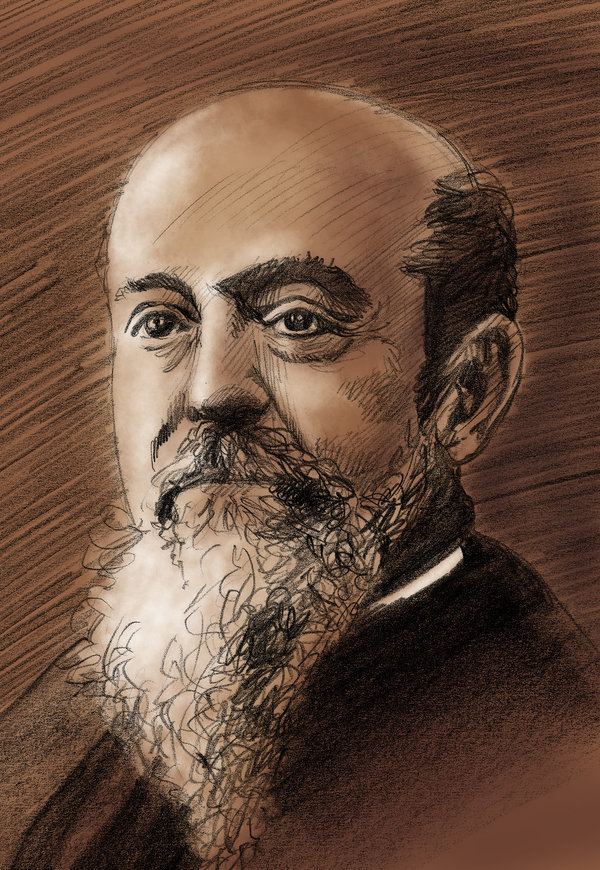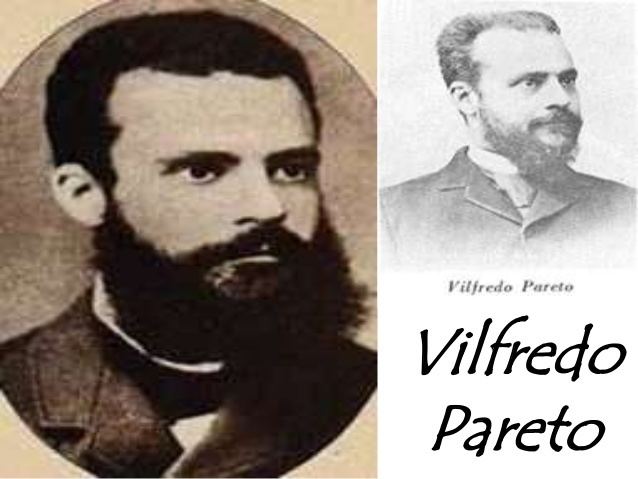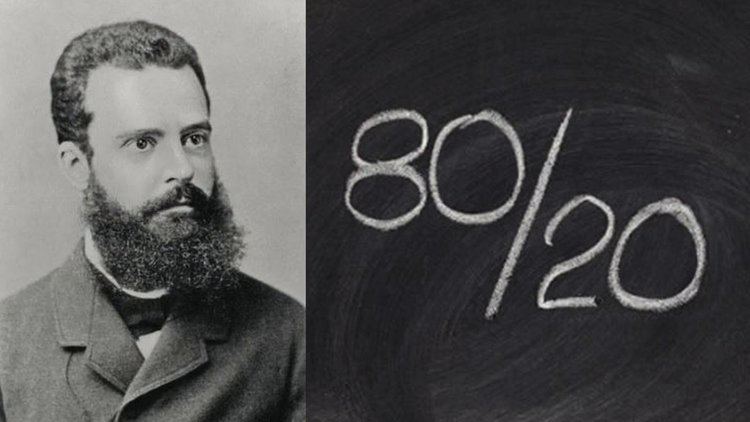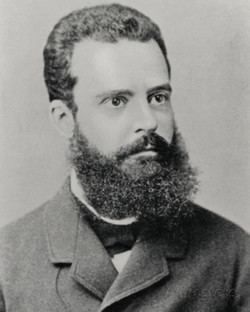Name Vilfredo Pareto Role Economist | ||
 | ||
Field MicroeconomicsSocioeconomics Influences Niccolo MachiavelliMaffeo PantaleoniAuguste ComteHerbert SpencerLeon Walras Contributions Pareto indexPareto chartPareto's lawPareto efficiencyPareto distributionPareto principle Parents Raffaele Pareto, Marie Metenier Books The Mind and Society, Manual of political economy, The transformation of democr, The rise and fall of the elites, The ruling class in Italy befor Similar People Leon Walras, Gaetano Mosca, Joseph M Juran, Max Weber, Alfred Marshall | ||
Vilfredo Federico Damaso Pareto ([vilˈfreːdo paˈreːto]; born Wilfried Fritz Pareto, 15 July 1848 – 19 August 1923) was an Italian engineer, sociologist, economist, political scientist, and philosopher, now also known for the 80/20 rule, named after him as the Pareto principle. He made several important contributions to economics, particularly in the study of income distribution and in the analysis of individuals' choices. He was also responsible for popularising the use of the term "elite" in social analysis.
Contents
- Vilfredo pareto
- Elite Theory Gaetano Mosca and Vilfredo Pareto
- Biography
- From Civil engineer to liberal and then to economist
- Economics and sociology
- Personal life
- Sociology
- Fascism and power distribution
- Economic concepts
- Concepts
- Major works
- Works in English translation
- Articles
- References

He introduced the concept of Pareto efficiency and helped develop the field of microeconomics. He was also the first to discover that income follows a Pareto distribution, which is a power law probability distribution. The Pareto principle was named after him, and it was built on observations of his such as that 80% of the land in Italy was owned by about 20% of the population. He also contributed to the fields of sociology and mathematics, according to the mathematician Benoit Mandelbrot and Richard L. Hudson:

"His legacy as an economist was profound. Partly because of him, the field evolved from a branch of moral philosophy as practised by Adam Smith into a data intensive field of scientific research and mathematical equations. His books look more like modern economics than most other texts of that day: tables of statistics from across the world and ages, rows of integral signs and equations, intricate charts and graphs."

Vilfredo pareto
Elite Theory: Gaetano Mosca and Vilfredo Pareto
Biography

Pareto was born of an exiled noble Genoese family in 1848 in Paris, the centre of the popular revolutions of that year. His father, Raffaele Pareto (1812–1882), was an Italian civil engineer and Ligurian marquis who had left Italy much like Giuseppe Mazzini and other Italian nationalists. His mother, Marie Metenier, was a French woman. Enthusiastic about the 1848 German revolution, his parents named him Fritz Wilfried, which became Vilfredo Federico upon his family's move back to Italy in 1858. In his childhood, Pareto lived in a middle-class environment, receiving a high standard of education, attending the new created Istituto Tecnico Leardi where Fernando Pio Rosellini was his mathematics professor. In 1869, he earned a doctor's degree in engineering from what is now the Polytechnic University of Turin (then the Technical School for Engineers). His dissertation was entitled "The Fundamental Principles of Equilibrium in Solid Bodies". His later interest in equilibrium analysis in economics and sociology can be traced back to this paper.
From Civil engineer to liberal, and then to economist
For some years after graduation, he worked as a civil engineer, first for the state-owned Italian Railway Company and later in private industry. He was manager of the Iron Works of San Giovanni Valdarno and later general manager of Italian Iron Works.
He did not begin serious work in economics until his mid-forties. He started his career a fiery liberal, besting the most ardent British liberals with his attacks on any form of government intervention in the free market. In 1886, he became a lecturer on economics and management at the University of Florence. His stay in Florence was marked by political activity, much of it fueled by his own frustrations with government regulators. In 1889, after the death of his parents, Pareto changed his lifestyle, quitting his job and marrying a Russian, Alessandrina Bakunina. She left him in 1902 for a young servant.
Economics and sociology
In 1893, he succeeded Léon Walras to the chair of Political Economy at the University of Lausanne in Switzerland where he remained for the rest of his life. In 1906, he made the famous observation that twenty percent of the population owned eighty percent of the property in Italy, later generalised by Joseph M. Juran into the Pareto principle (also termed the 80–20 rule). In one of his books published in 1909 he showed the Pareto distribution of how wealth is distributed, he believed "through any human society, in any age, or country". He maintained cordial personal relationships with individual socialists, but always thought their economic ideas were severely flawed. He later became suspicious of their humanitarian motives and denounced socialist leaders as an 'aristocracy of brigands' who threatened to despoil the country and criticized the government of Giovanni Giolitti for not taking a tougher stance against worker strikes. Growing unrest among labor in Italy led him to the anti-socialist and anti-democratic camp. His attitude toward fascism in his last years is a matter of controversy.
Personal life
In 1923 Pareto remarried with Jeanne Regis, just before he died in Geneva, Switzerland, 19 August 1923, "among a menagerie of cats that he and his French lover kept" in their villa; "the local divorce laws prevented him from divorcing his wife and remarrying until just a few months prior to his death".
Sociology
Pareto's later years were spent in collecting the material for his best-known work, Trattato di sociologia generale (1916) (The Mind and Society, published in 1935). His final work was Compendio di sociologia generale (1920).
In his Trattato di Sociologia Generale (1916, rev. French trans. 1917), published in English by Harcourt, Brace in a four-volume edition edited by Arthur Livingston under the title The Mind and Society (1935), Pareto developed the notion of the circulation of elites, the first social cycle theory in sociology. He is famous for saying "history is a graveyard of aristocracies".
Pareto seems to have turned to sociology for an understanding of why his abstract mathematical economic theories did not work out in practice, in the belief that unforeseen or uncontrollable social factors intervened. His sociology holds that much social action is nonlogical and that much personal action is designed to give spurious logicality to non-rational actions. We are driven, he taught, by certain "residues" and by "derivations" from these residues. The more important of these have to do with conservatism and risk-taking, and human history is the story of the alternate dominance of these sentiments in the ruling elite, which comes into power strong in conservatism but gradually changes over to the philosophy of the "foxes" or speculators. A catastrophe results, with a return to conservatism; the "lion" mentality follows. This cycle might be broken by the use of force, says Pareto, but the elite becomes weak and humanitarian and shrinks from violence.
Pareto's sociology was introduced to the United States by George Homans and Lawrence J. Henderson at Harvard, and had considerable influence, especially on Harvard sociologist Talcott Parsons, who developed a systems approach to society and economics that argues the status quo is usually functional.
Pareto was a lifelong opponent of Marxism.
Fascism and power distribution
Benoît Mandelbrot writes:
One of Pareto's equations achieved special prominence, and controversy. He was fascinated by problems of power and wealth. How do people get it? How is it distributed around society? How do those who have it use it? The gulf between rich and poor has always been part of the human condition, but Pareto resolved to measure it. He gathered reams of data on wealth and income through different centuries, through different countries: the tax records of Basel, Switzerland, from 1454 and from Augsburg, Germany, in 1471, 1498 and 1512; contemporary rental income from Paris; personal income from Britain, Prussia, Saxony, Ireland, Italy, Peru. What he found – or thought he found – was striking. When he plotted the data on graph paper, with income on one axis, and number of people with that income on the other, he saw the same picture nearly everywhere in every era. Society was not a "social pyramid" with the proportion of rich to poor sloping gently from one class to the next. Instead it was more of a "social arrow" – very fat on the bottom where the mass of men live, and very thin at the top where sit the wealthy elite. Nor was this effect by chance; the data did not remotely fit a bell curve, as one would expect if wealth were distributed randomly. "It is a social law", he wrote: something "in the nature of man".
Pareto's discovery that power laws applied to income distribution embroiled him in political change and the nascent Fascist movement, whether he really sided with the Fascists or not. Fascists such as Mussolini found inspiration for their own economic ideas in his discoveries. He had discovered something that was harsh and Darwinian, in Pareto's view. And this fueled both the anger and the energy of the Fascist movement because it fueled their economic and social views. He wrote that, as Mandelbrot summarizes:
At the bottom of the Wealth curve, he wrote, Men and Women starve and children die young. In the broad middle of the curve all is turmoil and motion: people rising and falling, climbing by talent or luck and falling by alcoholism, tuberculosis and other kinds of unfitness. At the very top sit the elite of the elite, who control wealth and power for a time – until they are unseated through revolution or upheaval by a new aristocratic class. There is no progress in human history. Democracy is a fraud. Human nature is primitive, emotional, unyielding. The smarter, abler, stronger, and shrewder take the lion's share. The weak starve, lest society become degenerate: One can, Pareto wrote, 'compare the social body to the human body, which will promptly perish if prevented from eliminating toxins.' Inflammatory stuff – and it burned Pareto's reputation.
Pareto had argued that democracy was an illusion and that a ruling class always emerged and enriched itself. For him, the key question was how actively the rulers ruled. For this reason he called for a drastic reduction of the state and welcomed Benito Mussolini's rule as a transition to this minimal state so as to liberate the "pure" economic forces.
To quote Pareto's biographer:
In the first years of his rule Mussolini literally executed the policy prescribed by Pareto, destroying political liberalism, but at the same time largely replacing state management of private enterprise, diminishing taxes on property, favoring industrial development, imposing a religious education in dogmas.
Karl Popper dubbed him the "theoretician of totalitarianism", but there is no evidence in Popper's published work that he read Pareto in any detail before repeating what was then a common but dubious judgment in anti-fascist circles.
It is true that Pareto regarded Mussolini's triumph as a confirmation of certain of his ideas, largely because Mussolini demonstrated the importance of force and shared his contempt for bourgeois parliamentarism. He accepted a "royal" nomination to the Italian senate from Mussolini. But he died less than a year into the new regime's existence.
Some fascist writers were much enamored of Pareto, writing such paeans as:
Just as the weaknesses of the flesh delayed, but could not prevent, the triumph of Saint Augustine, so a rationalistic vocation retarded but did not impede the flowering of the mysticism of Pareto. For that reason, Fascism, having become victorious, extolled him in life, and glorifies his memory, like that of a confessor of its faith.
But many modern historians reject the notion that Pareto's thought was essentially fascistic or that he is properly regarded as a supporter of fascism. Renato Crillo concluded that Pareto was a radical libertarian to the end. Renato Crillo writes: Some have seen in his sociological works the foundations of fascism. This is not correct. Even fascist writers did not find much merit in these works, and definitely condemned his economic theories.
Economic concepts
Pareto Theory Of Maximum Economics
Pareto turned his interest to economic matters and he became an advocate of free trade, finding himself in difficulty with the Italian government. His writings reflected the ideas of Léon Walras that economics is essentially a mathematical science. Pareto was a leader of the "Lausanne School" and represents the second generation of the Neoclassical Revolution. His "tastes-and-obstacles" approach to general equilibrium theory was resurrected during the great "Paretian Revival" of the 1930s and has influenced theoretical economics since.
In his Manual of Political Economy (1906) the focus is on equilibrium in terms of solutions to individual problems of "objectives and constraints". He used the indifference curve of Edgeworth (1881) extensively, for the theory of the consumer and, another great novelty, in his theory of the producer. He gave the first presentation of the trade-off box now known as the "Edgeworth-Bowley" box.
Pareto was the first to realize that cardinal utility could be dispensed with and economic equilibrium thought of in terms of ordinal utility – that is, it was not necessary to know how much a person valued this or that, only that he preferred X of this to Y of that. Utility was a preference-ordering. With this, Pareto not only inaugurated modern microeconomics, but he also demolished the alliance of economics and utilitarian philosophy (which calls for the greatest good for the greatest number; Pareto said "good" cannot be measured). He replaced it with the notion of Pareto-optimality, the idea that a system is enjoying maximum economic satisfaction when no one can be made better off without making someone else worse off. Pareto optimality is widely used in welfare economics and game theory. A standard theorem is that a perfectly competitive market creates distributions of wealth that are Pareto optimal.
Concepts
Some economic concepts in current use are based on his work:
He argued that in all countries and times, the distribution of income and wealth is highly skewed, with a few holding most of the wealth. He argued that all observed societies follow a regular logarithmic pattern:
-
log N = log A + m log x
where N is the number of people with wealth higher than x, and A and m are constants. Over the years, Pareto's Law has proved remarkably close to observed data.
